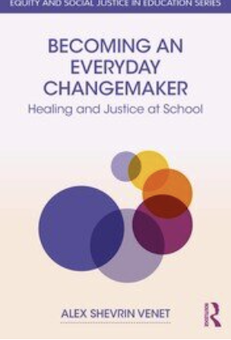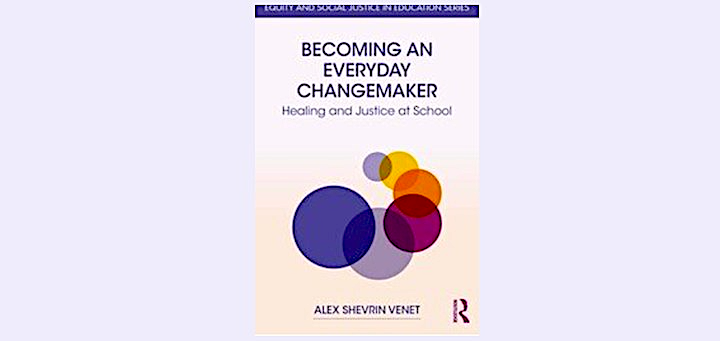Becoming an Everyday Changemaker: Healing and Justice at School
By Alex Shevrin Venet
(Routledge/Eye On Education, 2024 – Learn more)
Reviewed by Randy Ross

 Books and pamphlets about how to be a social justice activist, an everyday changemaker as Alex Shevrin Venet describes us, can be found within a deep-seated, wide-ranging tradition in this country. I include myself here. During my fifty plus years as an educator (Pre-K through adults), I have always been, in some way, a social justice advocate.
Books and pamphlets about how to be a social justice activist, an everyday changemaker as Alex Shevrin Venet describes us, can be found within a deep-seated, wide-ranging tradition in this country. I include myself here. During my fifty plus years as an educator (Pre-K through adults), I have always been, in some way, a social justice advocate.
As you read Becoming an Everyday Changemaker, you will hopefully be asking yourself how you can become a changemaker in your own middle level setting. If you already identify as one, this book will enable you to clarify, perhaps even shift, your changemaker approach, and to hone your already plentiful skills.
How to become an equity-centered, trauma-informed changemaker

 Thousands of journal articles and books explain the need for (the Why) and the content (the What) of equity-focused change. For example, the profound need for and the critical content of multicultural curricula is well-documented. Venet has written this enlightening book solely for educators to help us explore the “How” of effective social justice changemaking.
Thousands of journal articles and books explain the need for (the Why) and the content (the What) of equity-focused change. For example, the profound need for and the critical content of multicultural curricula is well-documented. Venet has written this enlightening book solely for educators to help us explore the “How” of effective social justice changemaking.
She articulates her approach using everyday examples, with personal, often quite moving, stories. She also offers readers moments of reflection and useful exercises to work with her proposed practices.
Venet’s opening chapter, “How we move through change matters,” prepares the soil and plants the seeds for what is yet to come. “The process is the point,” she writes. While a focus on the outcomes we seek is important, how we get there, the process, either supports or even negates our hoped-for outcomes.
“Teacher collective decision-making” is one example Venet offers of outcome-focused vs. process-focused change. For outcome-focused change, she writes, “Once we make the change, teachers can be part of collective decision-making on their new teams.” But for process-focused change, she adds, “During the change process, we’ll enhance our collective decision-making by involving teachers in designing the new model.” Said differently, walk the walk, don’t just talk the talk!
In chapter 2, “Why trauma makes change hard(er),” Venet gives us another example – one only too familiar to middle level (and other) educators – of how hierarchical, top-down decision-making thwarts collective decision-making, potentially harming the very will to work for equity-centered change. She quotes a school counselor, frustrated by an administrator’s decision, saying, “each one of us demands agency, and adopting [a top-down] change process rejects that demand.”
Navigating the change journey while attending to trauma
In her Part 2 – “Equity-centered trauma-informed skills for navigating the change journey” – Venet refers frequently to her previous book, Equity-Centered Trauma-informed Education (reviewed here and highlighted by Venet here). That book will soon be atop the pile on my desk!
Her humanizing approach to trauma emphasizes the healing effects of a “circle of care,” of deep relationships, particularly those that embody what I call “empathy across differences.” She also holds up the need for changemakers to “slow down,” to care for ourselves, integrating self-compassion, a survival necessity as we do the demanding work that too often feels fruitless.
Venet explores the complexities of trauma as interwoven with the work of equity-oriented changemaking. Three areas she highlights include (1) past individual trauma, (2) systemic/group trauma, and (3) the trauma of change itself. This third area captures an idea we rarely consider. Even potentially positive change, when the outcome remains uncertain, can raise anxiety to the level of trauma.
Consider the traumas of the thousands of students and educators who have lost their schools (perhaps even their homes) in the devastating, climate change-driven fires and floods of the past few years. They may get back to school, but where, under what conditions, with whom? “Getting back to school” may restore some sense of normalcy, theoretically a positive change, but nevertheless potentially will also raise additional traumas.
Chapter 8, “Working from strengths,” unpacks how each of us can contribute as changemakers from our strengths at any given time, without guilt that we cannot do more or what others can do. Venet describes her own frustration about not being able to physically support her community after she became disabled from a spine injury during the Covid pandemic. Yet she found ways that fit her capabilities at the time. She urges us to work from our own strengths, still working collectively for our common goals of social justice in schools. (As for me, I am 80 years old with physical limitations, but I can still write, supporting other, more able changemakers!).
Where do we find the strength as changemakers to face challenges such as defending books that foster racial, ethnic, or LGBTQ+ perspective-taking (another example of empathy across differences)? How can we maintain our engagement over the long haul? Venet emphasizes the centrality of empowerment, of empowered engagement. She quotes a teacher who said, after a crisis had impacted her school, that she and her fellow teachers felt empowered “to take risks in order to meet the needs of our students.” Engagement, empowerment, and risk-taking are basic requirements for Becoming an Everyday Changemaker.
How do we know if our efforts are bearing fruit?
In chapter 9, “Tuning into many streams of information,” Venet discusses ways of learning whether and how our change efforts are impacting those who most need equity transformations. Observing and sensing students’ and adults’ emotions in a school is one “stream of information.”
She writes, “We can cultivate a sense of curiosity about emotional information…to seek understanding.” Curiosity! Can we educators match the passionate curiosity of our middle level students about the world, about their social spheres, and especially about ideas or events that adults don’t want to talk about?
Another “stream of information” flows from our and our students’ expressions of identity. True social justice must include safety, both physical and emotional. The safer educators and our students feel in expressing our identities, the more we know about how our change efforts are working. Are LGBTQ+ students and staff more willing to openly share their identities, feeling safe to do so? Other sources of information about identity safety include the stories we tell about ourselves and those close to us.
Throughout Becoming an Everyday Changemaker, Venet venerates relationships as the foundation of fostering belonging through building community, of making change, every day. As we navigate the innumerable challenges of 2025 and beyond, please keep in mind her prescient warning, “We can’t know what crises await us in the future. We can’t plan for them all. But we can bet that to survive future crises, we will need one another.”
Randy Ross is currently an educational author and consultant. For the past 50+ years, she has worked on equity issues with PK-12 schools, districts, state education departments, and numerous nonprofits. She has been a preschool and middle school teacher, K-5 principal, adjunct instructor, professional development facilitator, school climate coach, and recently project manager of a middle school antibullying initiative.
Randy is past Co-Chair and Board member of SEL4MA and National Advisor to SEL4US. She has published numerous articles on equity issues in education. She is co-author of Little Learners, Big Hearts: A Teacher’s Guide to Nurturing Empathy and Equity in Early Childhood and Advancing Empathy and Equity in Early Childhood Education: A Leader’s Guide to Little Learners, Big Hearts (both Solution Tree Press, 2024). Randy is currently writing a book tentatively titled Empathy Across Differences: Seven Missing Pieces to Educators’ Empathy Puzzle (Solution Tree, 2026).









